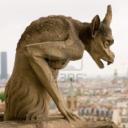Yahoo Answers is shutting down on May 4th, 2021 (Eastern Time) and the Yahoo Answers website is now in read-only mode. There will be no changes to other Yahoo properties or services, or your Yahoo account. You can find more information about the Yahoo Answers shutdown and how to download your data on this help page.
Trending News
Why white hair in the 18th century?
I've noticed that in 18th century, people always had white or really light colored hair in paintings and portraits. Hardly anyone had dark hair. And whenever women didn't wear wigs, they have either blonde or dirty light blonde or ash gray hair (nothing too close to being a brunette) in paintings. Did they use powder to keep it a lighter shade? Was it considered "more attractive" to have white or gray hair back then?
Here are some examples:
http://coilhouse.net/wp-content/uploads/dubarry2.j...
http://www.sanfranciscosentinel.com/wp-content/upl...
14 Answers
- ajt575sLv 51 decade agoFavorite Answer
They actually wore powdered wigs. Every now and then, you'll find a portrait of someone without the wig, and you'll notice that they have different colors of hair like everyone else. Most of the time, portraits of people with normal hair from that time are portraits of lower class people; the wigs were a sign of class. They didn't bathe much and perfumed the wigs, too, to cover the odor. I think they wore the wigs because they didn't wash their hair (a bath once a year was pretty typical), and unwashed hair is very unattractive, as you can guess.
It was just a fashion thing, I think. Someday people will look back at 2008 and wonder why we wore these clothes or did the things we do to look "beautiful" (tanning obsessively, bleaching our teeth until they practically glow in the dark, huge breast implants, etc.). As you can probably see, these "beauty" treatments are typically done by the rich who can afford it, while the poor go without breast implants, fancy dental treatments, etc.
Source(s): I have studied history in college and as a hobby. - The HistorianLv 51 decade ago
The wig became fashionable around 1624 wheb Louis XIII of France went prematurely bald. He started wearing a wig to disguise the fact. By the time his son came to the throne the look had spread throughout Europe, probably because it did help with the lice. Around 1715, lighter colored wigs were in fashion so, after unsuccessful attempts at making the color of bleached wigs stable, people started to use powder instead. Hair powder was made from finely ground starch, scented with orange flower, lavender, or orris root, and occasionally colored blue, violet, pink or yellow, but most often white.
Source(s): http://costumes.org/history/100pages/18THHAIR.HTM http://en.wikipedia.org/wiki/Wig_(hair) http://www.marquise.de/en/1700/howto/frisuren/fris... http://www.historycooperative.org/journals/ahr/111... - CabalLv 71 decade ago
Wig started out coloured, they were made from real hair after all for the most expensive ones so you had a range of colour available.
Much later came the habit to use either floor, starch or rice powder on them to whiten them, which was difficult to do and a pain to wear. So white horse hair started to be used. As it was much cheaper lower classes started to wear them too.
The reason why white powder was used seems to be fashion, it was a time when you had to have a white face so why not whiten the hair too?
- old ladyLv 71 decade ago
Most of the white hair was wigs, and the wigs were powdered to keep them white. The custom began in France, in the royal court, and spread from there. It continues to this day in some circles - supreme court judges and lawyers, for example, still wear white wigs, called perukes.
- JVHawai'iLv 71 decade ago
Wish I could sing this one too you - - - imagine a chorus of Colonial Men & Women Singing Merrilly!!
L I C E
L I C E
L I C E
Many of the powders used to powder either hair or wigs was thought to alleviate the itching of lice. And guess what, this might make you squeamish, but it is easier usiing tweezers to pick out black lice from a white wig!!!
As for painting and such, unlike modern days, blond hair was thought to be a sign of intelligence by white Anglo & Catholic Europeans - - - Blond as the Ideal Color regardless of the hair color of the postrait sitter!
Now stop scratching your scalp!!
http://www.nps.gov/archive/gewa/chlowb.htm
""One of the rituals for the established plantation owners was to powder and adjust ones wig. Men and women both wore powdered wigs to alleviate the torment of head lice. The powdered wig was seldom cleaned, but often powdered to reduce the stench of months, and even years of accumulated human grease.""
Source(s): Odd Note - - - Geo Washington was a Natural Blond whose Hair stayed thick Until Late in Life, He was Envied by others for his natural hair lightly powdered, Washington was one of the few peopkle who washed his hair regularly! - 1 decade ago
That's a good question. I guess dark hair was unfashionable, as was tanning your skin and a light complexion was beautiful in that time. Also, some people had crap hair back in the day, and probably wanted to cover it up. Long hair was the thing two, so they bought wigs.
Maybe they didn't have dyes at the time?
- Anonymous1 decade ago
They wore wigs that were powedered white so that they looked old and wise. Really! People used to respect older people instead of locking them away never to be seen again.












